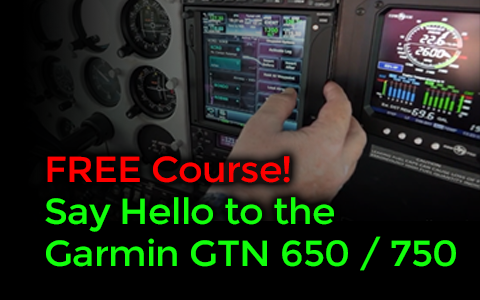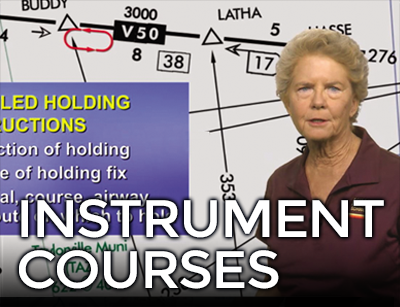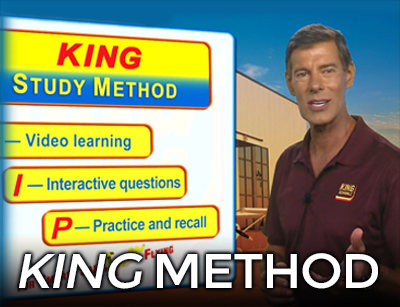ACS Missed Question Codes - Instrument Rating
FAA Missed ACS Codes
for Instrument Rating Exams
Instrument Rating ACS Exams
Got some missed questions on your Instrument Pilot written test? No worries, it happens to all of us. If the codes listed on your test results start with "IR", you're in the right place. Your Instrument Rating ACS (Once known as PLT) missed question codes will be listed below, and you can see which subject areas to study more before your checkride. Keep in mind, you won't know exactly which questions you got wrong, only the general subjects missed of the IFR ACS.
- If you missed any questions on your FAA Knowledge Test, you will find the Airman Certification Standards codes on your test report.
- Your flight instructor will review the material of the missed Airman Certification Standards codes prior to taking your practical test.
Click Here to view, and if desired, download, your ACS document.
ACS Code
Knowledge Area
IR.I.A.K1
Certification requirements, recency of experience, and recordkeeping.
IR.I.A.K2
Privileges and limitations.
IR.I.A.K3
Part 68 BasicMed Privileges and Limitations.
IR.I.B.K1
Sources of weather data (e.g., National Weather Service, Flight Service) for flight planning purposes.
IR.I.B.K2
Acceptable weather products and resources utilized for preflight planning, current and forecast weather for departure and en route operations and arrival phases of flight.
IR.I.B.K3
Meteorology applicable to the departure, en route, alternate, and destination for flights conducted under Instrument Flight Rules (IFR) to include expected climate and hazardous conditions such as:
IR.I.B.K3a
a. Atmospheric composition and stability
IR.I.B.K3b
b. Wind (e.g., crosswind, tailwind, windshear, mountain wave, etc.)
IR.I.B.K3c
c. Temperature
IR.I.B.K3d
d. Moisture/precipitation
IR.I.B.K3e
e. Weather system formation, including air masses and fronts
IR.I.B.K3f
f. Clouds
IR.I.B.K3g
g. Turbulence
IR.I.B.K3h
h. Thunderstorms and microbursts
IR.I.B.K3i
i. Icing and freezing level information
IR.I.B.K3j
j. Fog/mist
IR.I.B.K3k
k. Frost
IR.I.B.K3l
l. Obstructions to visibility (e.g., smoke, haze, volcanic ash, etc.)
IR.I.B.K4
Flight deck displays of digital weather and aeronautical information.
IR.I.C.K1
Route planning, including consideration of the available navigational facilities, special use airspace, preferred routes, and alternate airports.
IR.I.C.K2
Altitude selection accounting for terrain and obstacles, glide distance of airplane, IFR cruising altitudes, effect of wind, and oxygen requirements.
IR.I.C.K3
Calculating:
IR.I.C.K3a
a. Time, climb and descent rates, course, distance, heading, true airspeed, and groundspeed
IR.I.C.K3b
b. Estimated time of arrival to include conversion to universal coordinated time (UTC)
IR.I.C.K3c
c. Fuel requirements, to include reserve
IR.I.C.K4
Elements of an IFR flight plan.
IR.I.C.K5
Procedures for activating and closing an IFR flight plan in controlled and uncontrolled airspace.
IR.II.A.K1
The general operational characteristics and limitations of applicable anti-icing and deicing systems, including airframe, propeller, intake, fuel, and pitot-static systems.
IR.II.B.K1
Operation of their airplane’s applicable flight instrument system(s) including:
IR.II.B.K1a
a. Pitot-static instrument system: altimeter, airspeed indicator, vertical speed indicator
IR.II.B.K1b
b. Gyroscopic/electric/vacuum instrument system: attitude indicator, heading indicator, turn-and-slip indicator/turn coordinator
IR.II.B.K1c
c. Electrical systems, electronic flight instrument displays (PFD, MFD), transponder, and ADS-B
IR.II.B.K1d
d. Magnetic compass
IR.II.B.K2
Operation of their airplane’s applicable navigation system(s) including:
IR.II.B.K2a
a. VOR, DME, ILS, marker beacon receiver/indicators
IR.II.B.K2b
b. RNAV, GPS, Wide Area Augmentation System (WAAS), FMS, autopilot
IR.II.C.K1
Purpose of performing an instrument flight deck check and how to detect possible defects.
IR.II.C.K2
IFR airworthiness, to include airplane inspection requirements and required equipment for IFR flight.
IR.II.C.K3
Required procedures, documentation, and limitations of flying with inoperative equipment.
IR.III.A.K1
Elements and procedures related to ATC clearances and pilot/controller responsibilities for departure, en route, and arrival phases of flight including clearance void times.
IR.III.A.K2
PIC emergency authority.
IR.III.A.K3
Lost communication procedures and procedures for flights outside of radar environments.
IR.III.B.K1
Elements related to holding procedures, including reporting criteria, appropriate speeds, and recommended entry procedures for standard, nonstandard, published, and nonpublished holding patterns.
IR.IV.A.K1
Elements related to attitude instrument flying during straight-and-level flight, climbs, turns, and descents while conducting various instrument flight procedures.
IR.IV.A.K2
Interpretation, operation, and limitations of pitch, bank, and power instruments.
IR.IV.A.K3
Normal and abnormal instrument indications and operations.
IR.IV.B.K1
Procedures for recovery from unusual flight attitudes.
IR.IV.B.K2
Unusual flight attitude causal factors, including physiological factors, system and equipment failures, and environmental factors.
IR.V.A.K1
Ground-based navigation (orientation, course determination, equipment, tests and regulations) including procedures for intercepting and tracking courses and arcs.
IR.V.A.K2
Satellite-based navigation (orientation, course determination, equipment, tests and regulations, interference, appropriate use of databases, RAIM, and WAAS) including procedures for intercepting and tracking courses and arcs.
IR.V.B.K1
Elements related to ATC routes, including departure procedures (DPs) and associated climb gradients; arrival procedures (STARs) and associated constraints.
IR.V.B.K2
Pilot/controller responsibilities, communication procedures, and ATC services available to pilots.
IR.VI.A.K1
Procedures and limitations associated with a nonprecision approach, including the differences between Localizer Performance (LP) and Lateral Navigation (LNAV) approach guidance.
IR.VI.A.K2
Navigation system annunciations expected during an RNAV approach.
IR.VI.A.K3
Ground-based and satellite-based navigation systems used for a nonprecision approach.
IR.VI.A.K4
A stabilized approach, to include energy management concepts.
IR.VI.B.K1
Procedures and limitations associated with a precision approach, including determining required descent rates and adjusting minimums in the case of inoperative equipment.
IR.VI.B.K2
Navigation system displays, annunciations, and modes of operation.
IR.VI.B.K3
Ground-based and satellite-based navigation (orientation, course determination, equipment, tests and regulations, interference, appropriate use of navigation data, signal integrity)
IR.VI.B.K4
A stabilized approach, to include energy management concepts
IR.VI.C.K1
Elements related to missed approach procedures and limitations associated with standard instrument approaches, including while using an FMS or autopilot, if equipped.
IR.VI.D.K1
Elements related to circling approach procedures and limitations including approach categories and related airspeed restrictions.
IR.VI.E.K1
Elements related to the pilot’s responsibilities, and the environmental, operational, and meteorological factors that affect landing from a straight-in or circling approach.
IR.VI.E.K2
Airport signs, markings and lighting, to include approach lighting systems.
IR.VII.A.K1
Procedures to follow in the event of lost communication during various phases of flight, including techniques for reestablishing communications, when it is acceptable to deviate from an IFR clearance, and when to begin an approach at the destination.
IR.VII.B.K1
Procedures used if engine failure occurs during straight-and-level flight and turns while on instruments.
IR.VII.C.K1
Instrument approach procedures with one engine inoperative.
IR.VII.D.K1
Recognizing if primary flight instruments are inaccurate or inoperative, and advising ATC or the evaluator.
IR.VII.D.K2
Common failure modes of vacuum and electric attitude instruments and how to correct or minimize the effect of their loss.
IR.VIII.A.K1
Procedures for checking the functionality of all installed instruments and navigation equipment.













